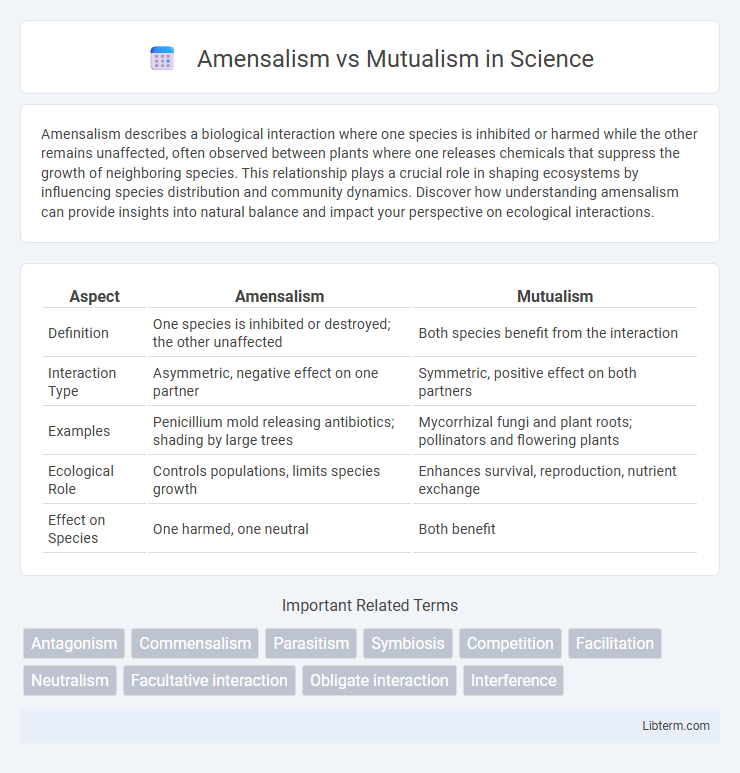Amensalism describes a biological interaction where one species is inhibited or harmed while the other remains unaffected, often observed between plants where one releases chemicals that suppress the growth of neighboring species. This relationship plays a crucial role in shaping ecosystems by influencing species distribution and community dynamics. Discover how understanding amensalism can provide insights into natural balance and impact your perspective on ecological interactions.
Table of Comparison
| Aspect | Amensalism | Mutualism |
|---|---|---|
| Definition | One species is inhibited or destroyed; the other unaffected | Both species benefit from the interaction |
| Interaction Type | Asymmetric, negative effect on one partner | Symmetric, positive effect on both partners |
| Examples | Penicillium mold releasing antibiotics; shading by large trees | Mycorrhizal fungi and plant roots; pollinators and flowering plants |
| Ecological Role | Controls populations, limits species growth | Enhances survival, reproduction, nutrient exchange |
| Effect on Species | One harmed, one neutral | Both benefit |
Introduction to Species Interactions
Species interactions such as amensalism and mutualism play crucial roles in ecosystem dynamics by shaping population structures and resource distribution. Amensalism involves one species being inhibited or destroyed while the other remains unaffected, exemplified by the release of antibiotics by certain fungi impacting bacteria. Mutualism benefits both species through cooperative interactions like pollination between bees and flowering plants, enhancing survival and reproductive success.
Defining Amensalism
Amensalism is an ecological interaction where one organism is inhibited or destroyed while the other remains unaffected, often seen in cases like fungi secreting antibiotics that kill nearby bacteria. This contrasts with mutualism, where both species benefit from the relationship, such as bees pollinating flowers while obtaining nectar. Understanding amensalism highlights the asymmetric impact on species populations within ecosystems, emphasizing the complex dynamics beyond cooperative interactions.
Understanding Mutualism
Mutualism is a type of symbiotic relationship where both species benefit, enhancing survival, reproduction, or growth; examples include bees pollinating flowers and receiving nectar in return. This interaction contrasts with amensalism, where one organism is inhibited or destroyed while the other remains unaffected, such as the release of antibiotics by fungi that suppress bacteria. Understanding mutualism involves examining the ecological and evolutionary advantages exchanged, which promote biodiversity and ecosystem stability.
Key Differences Between Amensalism and Mutualism
Amensalism involves one species being inhibited or destroyed while the other remains unaffected, commonly seen in cases like penicillin-producing molds suppressing bacteria. Mutualism benefits both species through interactions such as pollinators and flowering plants exchanging resources. The key difference lies in impact direction: amensalism harms one party without advantage, whereas mutualism provides reciprocal benefits to both organisms involved.
Ecological Examples of Amensalism
Amensalism is an ecological interaction where one species is inhibited or harmed while the other remains unaffected, exemplified by black walnut trees releasing juglone, a compound toxic to many nearby plants. This contrasts mutualism, where both species benefit, such as bees pollinating flowers while obtaining nectar. Amensalism highlights important species relationships that influence plant community dynamics and biodiversity without reciprocal benefits.
Real-World Cases of Mutualism
Mutualism exemplifies beneficial interactions between species, such as the symbiotic relationship between bees and flowering plants where bees obtain nectar while facilitating pollination. Coral reefs showcase mutualism through the partnership between corals and zooxanthellae algae, which exchange nutrients essential for coral growth and reef ecosystem health. These real-world cases highlight mutualism's critical role in ecosystem stability, biodiversity maintenance, and resource cycling.
Impact on Ecosystem Dynamics
Amensalism negatively affects one species while leaving the other unaffected, often leading to reduced biodiversity and altered resource distribution in ecosystems. Mutualism promotes positive interactions where both species benefit, enhancing ecosystem productivity, resilience, and stability through cooperative relationships. These contrasting interactions shape community structures by influencing species populations and ecological balance differently.
Evolutionary Significance of Amensalism and Mutualism
Amensalism and mutualism represent contrasting ecological interactions that drive evolutionary processes by influencing species' survival and adaptation. Amensalism, often involving one species being inhibited or destroyed while the other remains unaffected, shapes evolutionary pathways by exerting selective pressure and promoting traits that enable resistance or avoidance, contributing to biodiversity maintenance. Mutualism fosters coevolution through reciprocal benefits, enhancing fitness and driving specialization, which accelerates evolutionary innovation and ecological complexity.
Human Influence on Species Relationships
Human activities significantly alter amensalism and mutualism dynamics, often disrupting natural species interactions. Habitat destruction, pollution, and introduction of invasive species undermine mutualistic relationships by reducing biodiversity and resource availability. Conversely, these disruptions can intensify amensalism by creating imbalance and increased competition among native species.
Future Perspectives in Studying Species Interactions
Future perspectives in studying amensalism and mutualism emphasize integrative approaches combining genomics, metabolomics, and ecological modeling to unravel complex species interactions. Advanced bioinformatics tools and machine learning will enable precise predictions of interaction outcomes under changing environmental conditions. These insights will facilitate the development of sustainable ecosystem management and conservation strategies by harnessing beneficial mutualistic relationships while mitigating negative amensalistic effects.
Amensalism Infographic

 libterm.com
libterm.com